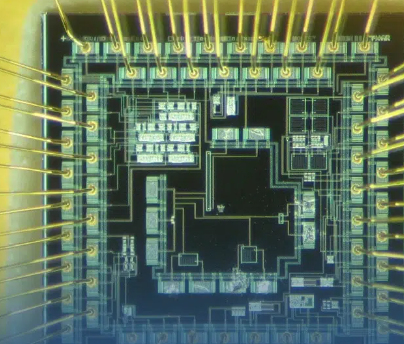What is Hybrid Integrated Circuit (HIC)
A hybrid integrated circuit (IC) is a miniaturized electronic circuit that combines multiple components within a single package, including passive components like resistors and capacitors, and active components such as transistors and diodes. It typically involves the integration of discrete components onto a substrate using thick film or thin film technology. These circuits are used in a wide range of applications, from consumer electronics to industrial control systems, due to their compact size, low power consumption, high reliability, and cost-effectiveness.

What are types of integrated circuit1. Analog Integrated Circuits (ICs) – These ICs are used for amplification, filtering, and processing analog signals such as audio and radio frequency signals.
2. Microelectromechanical Systems (MEMS) ICs- These ICs integrate mechanical elements such as sensors or actuators into microchips. MEMS ICs have applications in automotive and consumer electronics industries.
3. Radio Frequency Integrated Circuits (RFICs) – RFICs are designed to work with frequencies ranging from a few kilohertz to GHz range. They are extensively used in wireless communication devices such as cell phones, GPS receivers and satellite dishes.
4. Power Management Integrated Circuits (PMICs) – PMICs regulate the power supply of an electronic device. Applications of PMICs can be seen in portable devices such as smartphones, tablets, laptops, etc.
5. ASIC(Application-Specific Integrated Circuit)-ASIC is custom-designed to meet specific application requirements such as high computational capacity or low-power consumption, resulting in highly efficient performance.
6.Hybrid integrated circuit. We will talk about this below.
What is hybrid integrated circuit
A hybrid integrated circuit (HIC) is a type of electronic circuit that combines multiple components on one substrate, typically ceramic or quartz. It consists of a combination of miniature passive and active electronic components like resistors, capacitors, transistors, diodes, and inductors that are mounted onto a single package by using small metallic wires or conductive pathways to connect them together.
Hybrid integrated circuits offer several advantages over traditional printed circuits such as higher component density, improved reliability, and customized functionality according to the specific application requirements. They are widely used in various industries including telecommunications, military, aerospace, medical, automotive, and consumer electronics.
What’s the feature of hybrid integrated circuit1. Compact size: Hybrid integrated circuits are small, compact and lightweight making them easy to install in different devices.
2. Customizable design: They can be designed to meet specific application needs with a customized combination of passive and active components.
3. Low power consumption: Hybrid integrated circuits consume minimal power requiring minimal maintenance due to low heat generation.
4. Robustness : Hybrid technology can support rugged applications that require high levels of resilience and compatibility with other systems’ requirements.
5. Easy to repair and modify : Hybrid integrated circuits can be easily repaired, replaced or modified through the stacked structure which allows for individual component replacement if need be.
6. Improved signal-to-noise ratio : Hybrid integrated circuitry has better shielding from noise because of its sealed construction during production.
What are advantages and disadvantage of HIC
Advantages of HIC:
1. Improved data quality: HICs are often better equipped to collect and process high-quality health data due to their advanced technological resources.
2. Access to cutting-edge technology: Patients can benefit from HIC’s use of state-of-the-art equipment for diagnosis, treatment and monitoring.
3. Enhanced scientific research: HICs have the capacity to conduct large-scale studies with diverse populations, which can lead to groundbreaking discoveries and improved medical interventions.
Disadvantages of HIC:
1. Economic burden: The development of advanced healthcare infrastructure and technologies is expensive and may not be feasible in developing countries or those that lack sufficient government support.
2. Unequal participation: Not all countries or regions worldwide have equal access to HIC facilities, creating disparities in health outcomes between these groups.
3. Limited focus on preventive care: While HICs excel at providing excellent tertiary care, there can sometimes be a lack of effort put into promoting preventative medicine and education.
4. Privacy concerns: With increased reliance on electronic health records and online platforms for health-related information dissemination, privacy and security concerns arise regarding how such sensitive information will be handled and safeguarded.
What is the manufacturing process hybrid integrated circuit
1. Design: A design engineer specifies the layout and function of the hybrid IC.
2. Substrate preparation: The substrate material, often ceramic or glass, is cut to size and polished to a smooth surface.
3. Deposition: Thin layers of various materials are deposited onto the substrate using techniques like sputtering or evaporation.
4. Component assembly: Individual semiconductor components and passive components are bonded to the substrate according to the design specifications.
在线留言询价
- 一周热料
- 紧缺物料秒杀
| 型号 | 品牌 | 询价 |
|---|---|---|
| TL431ACLPR | Texas Instruments | |
| CDZVT2R20B | ROHM Semiconductor | |
| BD71847AMWV-E2 | ROHM Semiconductor | |
| MC33074DR2G | onsemi | |
| RB751G-40T2R | ROHM Semiconductor |
| 型号 | 品牌 | 抢购 |
|---|---|---|
| ESR03EZPJ151 | ROHM Semiconductor | |
| STM32F429IGT6 | STMicroelectronics | |
| BU33JA2MNVX-CTL | ROHM Semiconductor | |
| IPZ40N04S5L4R8ATMA1 | Infineon Technologies | |
| TPS63050YFFR | Texas Instruments | |
| BP3621 | ROHM Semiconductor |
- 周排行榜
- 月排行榜
AMEYA360公众号二维码
识别二维码,即可关注
























